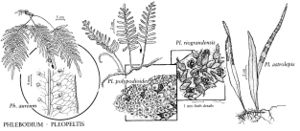Pleopeltis riograndensis
in Windham, Contr. Univ. Michigan Herb. 19: 46. 1993.
Stems short-creeping, sparingly branched, 2–3 mm diam.; scales subulate to lanceolate-acuminate, centrally clathrate with cell luminae large and clear, surfaces glabrous, margins lacerate-ciliate. Leaves to 20 cm, strongly hygroscopic. Petiole grooved, otherwise round in cross section, sparsely scaly; scales rarely overlapping, margins denticulate to ciliate. Blade triangular-oblong to ovate, deeply pinnatifid, to 5 cm wide, moderately scaly abaxially, glabrous adaxially; scales concolored to obscurely bicolored, usually dark reddish brown throughout, broadly ovate-lanceolate, clathrate, more than 0.5 mm wide, margins fringed-ciliate. Venation mostly free with occasional areoles, never more than 1 included veinlet in fertile areoles. Sori round, discrete, surficial to shallowly embossed, soral scales attached at periphery of receptacle. Spores smooth with scattered spheric deposits on surface, 60–74 µm. 2n = 148.
Phenology: Sporulating summer–fall.
Habitat: Growing on rocky slopes and ledges, and in crevices, usually in moist, shaded canyons
Elevation: 1500–2500 m
Distribution

Ariz., Tex., n Mexico.
Discussion
In the past Pleopeltis riograndensis has been treated as a variety of P. thyssanolepis, but it differs from the latter species in that the petiole and leaf are only sparsely scaly rather than densely so, the blade scales are mostly ovate or ovate-lanceolate rather than nearly spheric, the venation is mostly free rather than mostly areolate, and the basal segments of the blade are alternate rather than opposite to nearly opposite.
Selected References
None.
